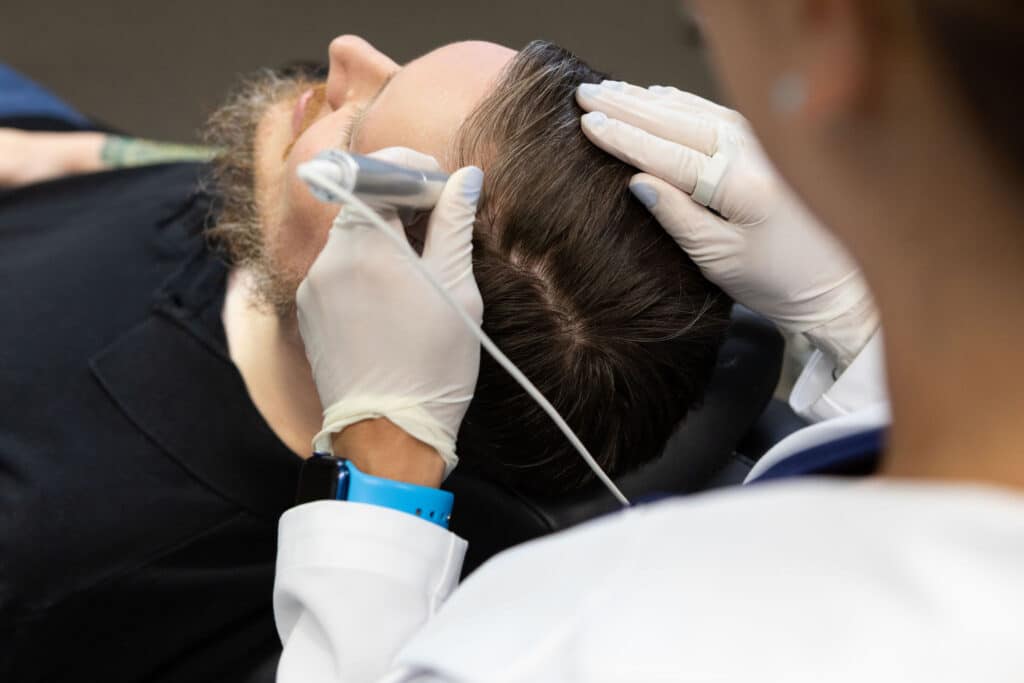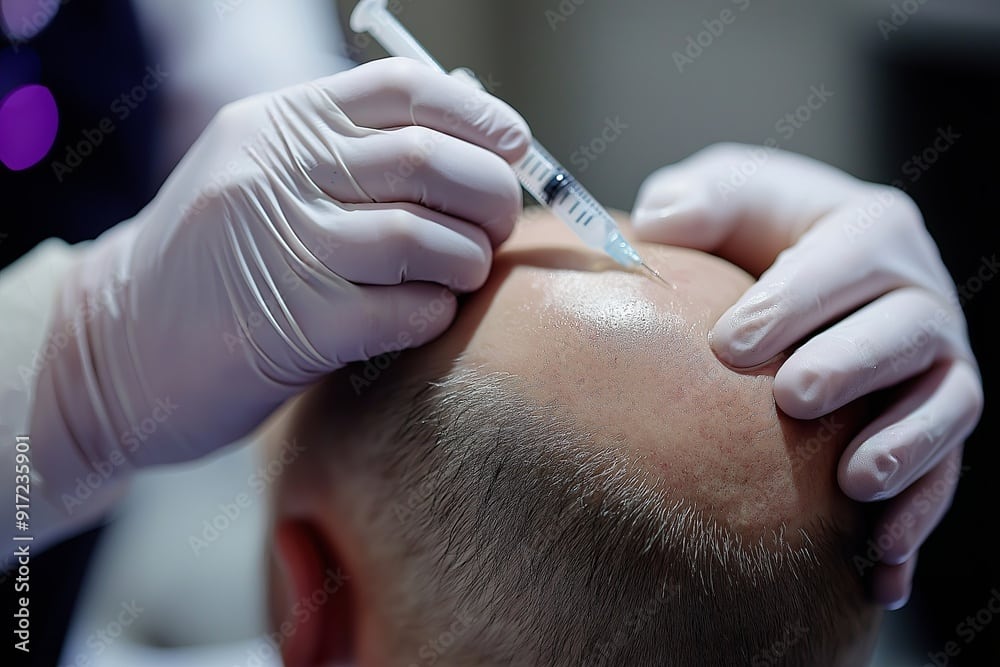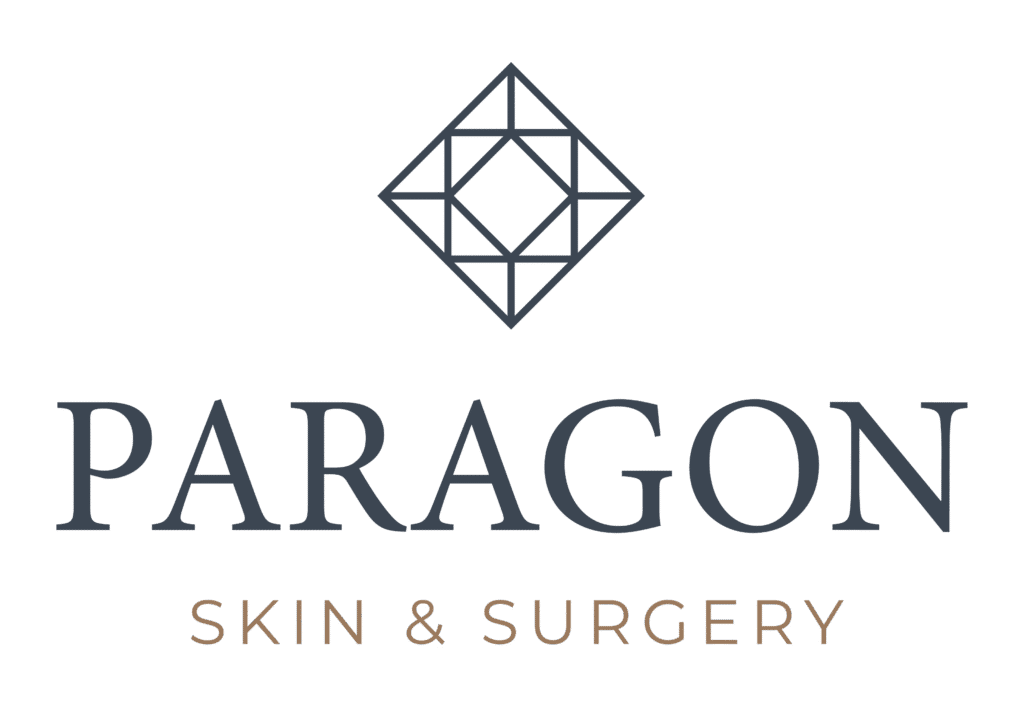Understanding Hair Restoration
Hair restoration using Platelet-Rich Plasma (PRP) is an innovative and effective treatment offered at Paragon Skin & Surgery. This non-surgical procedure harnesses the regenerative power of your own blood to stimulate hair growth, helping you regain thicker, fuller, and more luxurious locks for both men and women.
What is Hair Restoration Using PRP?
Hair restoration with PRP involves the extraction of a small amount of your blood, which is then processed to concentrate the platelets rich in growth factors. This PRP solution is injected into the scalp to stimulate hair follicles, promote hair regrowth, and improve overall hair health. PRP can be used to treat a variety of hair loss conditions, including androgenic alopecia (male and female pattern baldness) and thinning hair.
Why Choose PRP?
Growth Factor Richness: PRP is derived from the patient’s own blood, and it is rich in growth factors. Growth factors are proteins that play a crucial role in signaling cellular processes, including tissue repair and regeneration. When PRP is injected into the scalp, these growth factors stimulate the activity of hair follicles, promoting hair growth.
Stem Cell Stimulation: Platelets in PRP contain various growth factors that can stimulate the activity of stem cells in the hair follicles. Activating these stem cells contributes to the regeneration and maintenance of hair follicles, potentially leading to increased hair thickness and density.
Improved Blood Supply: PRP has the potential to improve blood supply to the hair follicles. The growth factors in PRP can enhance angiogenesis, the formation of new blood vessels, which helps deliver essential nutrients and oxygen to the follicles. Improved blood circulation supports a healthier environment for hair growth.
Non-Surgical and Minimal Downtime: PRP therapy is a non-surgical procedure that involves injecting the patient’s own blood components back into the scalp. As a minimally invasive treatment, it generally has minimal downtime compared to surgical hair restoration procedures. Patients can usually resume their regular activities shortly after the treatment.
Complementary to Other Treatments: PRP can be used as a standalone treatment or in conjunction with other hair restoration methods, such as medications (e.g., minoxidil, finasteride) Combining PRP with other modalities may enhance overall treatment outcomes.
Safety Profile: Since PRP is derived from the patient’s own blood, the risk of allergic reactions or rejection is minimal. It is generally considered a safe procedure when performed by qualified healthcare professionals.
How Is PRP for Hair Performed?
A small amount of your blood is drawn, typically from your arm, similar to a standard blood test. The drawn blood is processed in a centrifuge to separate and concentrate the platelets and growth factors, creating the PRP solution.The PRP solution is carefully injected into the scalp in targeted areas. This stimulates hair follicles, encourages hair growth, and enhances hair thickness. Over the following months, you will notice gradual hair regrowth and improved hair texture as PRP stimulates the follicles. Multiple sessions are recommended to achieve optimal results. PRP treatment for hair loss is a promising option for individuals seeking a non-surgical approach to stimulate hair growth.

Understanding Hair Restoration
What is Hair Restoration Using PRP?
Hair restoration with PRP involves the extraction of a small amount of your blood, which is then processed to concentrate the platelets rich in growth factors. This PRP solution is injected into the scalp to stimulate hair follicles, promote hair regrowth, and improve overall hair health. PRP can be used to treat a variety of hair loss conditions, including androgenic alopecia (male and female pattern baldness) and thinning hair.

Why Choose PRP?
Growth Factor Richness: PRP is derived from the patient’s own blood, and it is rich in growth factors. Growth factors are proteins that play a crucial role in signaling cellular processes, including tissue repair and regeneration. When PRP is injected into the scalp, these growth factors stimulate the activity of hair follicles, promoting hair growth.
Stem Cell Stimulation: Platelets in PRP contain various growth factors that can stimulate the activity of stem cells in the hair follicles. Activating these stem cells contributes to the regeneration and maintenance of hair follicles, potentially leading to increased hair thickness and density.
Improved Blood Supply: PRP has the potential to improve blood supply to the hair follicles. The growth factors in PRP can enhance angiogenesis, the formation of new blood vessels, which helps deliver essential nutrients and oxygen to the follicles. Improved blood circulation supports a healthier environment for hair growth.
Non-Surgical and Minimal Downtime: PRP therapy is a non-surgical procedure that involves injecting the patient’s own blood components back into the scalp. As a minimally invasive treatment, it generally has minimal downtime compared to surgical hair restoration procedures. Patients can usually resume their regular activities shortly after the treatment.
Complementary to Other Treatments: PRP can be used as a standalone treatment or in conjunction with other hair restoration methods, such as medications (e.g., minoxidil, finasteride) Combining PRP with other modalities may enhance overall treatment outcomes.
Safety Profile: Since PRP is derived from the patient’s own blood, the risk of allergic reactions or rejection is minimal. It is generally considered a safe procedure when performed by qualified healthcare professionals
How Is PRP for Hair Performed?
A small amount of your blood is drawn, typically from your arm, similar to a standard blood test. The drawn blood is processed in a centrifuge to separate and concentrate the platelets and growth factors, creating the PRP solution.The PRP solution is carefully injected into the scalp in targeted areas. This stimulates hair follicles, encourages hair growth, and enhances hair thickness. Over the following months, you will notice gradual hair regrowth and improved hair texture as PRP stimulates the follicles. Multiple sessions are recommended to achieve optimal results. PRP treatment for hair loss is a promising option for individuals seeking a non-surgical approach to stimulate hair growth.
PRP FAQs
Most patients report minimal discomfort during the procedure. Local anesthesia or numbing cream is often applied to ensure your comfort. Any discomfort is typically brief and well-tolerated.
Results can vary, but many individuals start to notice improvement within a few months. Hair growth typically continues to improve over several months as the PRP stimulates the hair follicles. Multiple sessions are recommended and will be discussed during your consultation.
PRP injections are generally well-tolerated, and side effects are minimal. You may experience minor swelling, redness, or mild discomfort at the injection sites, which usually subsides within a day or two. There is typically no downtime, and you can resume your regular activities immediately.
No, it is considered a cosmetic procedure and is not covered by insurance.



